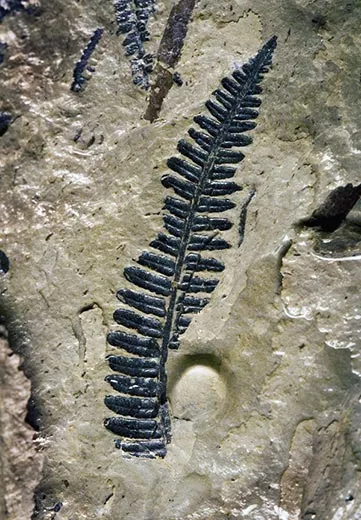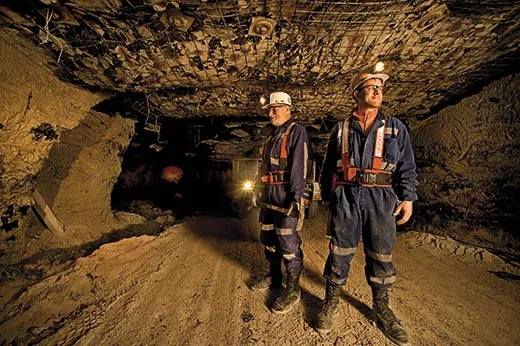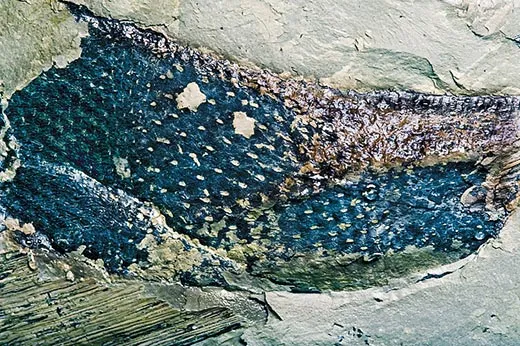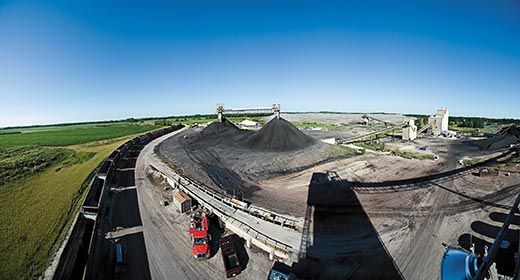The World’s Largest Fossil Wilderness
An Illinois coal mine holds a snapshot of life on earth 300 million years ago, when a massive earthquake “froze” a swamp in time
/https://tf-cmsv2-smithsonianmag-media.s3.amazonaws.com/filer/John-Nelson-Scott-Elrick-mine-shaft-forest-fossils-631.jpg)
Finding a fossil in a coal mine is no big deal. Coal deposits, after all, are petrified peat swamps, and peat is made from decaying plants, which leave their imprints in mud and clay as it hardens into shale stone.
But it was a different thing entirely when John Nelson and Scott Elrick, geologists with the Illinois State Geological Survey, examined the Riola and Vermilion Grove coal mines in eastern Illinois. Etched into ceilings of the mine shafts is the largest intact fossil forest ever seen—at least four square miles of tropical wilderness preserved 307 million years ago. That's when an earthquake suddenly lowered the swamp 15 to 30 feet and mud and sand rushed in, covering everything with sediment and killing trees and other plants. "It must have happened in a matter of weeks," says Elrick. "What we see here is the death of a peat swamp, a moment in geologic time frozen by an accident of nature."
To see this little-known wonder, I joined Nelson and Elrick at the Vermilion Grove site, a working mine operated by St. Louis-based Peabody Energy and closed to the public. I donned a hard hat, a light, gloves and steel-toed boots. I received an oxygen bottle and a safety lecture. In case of emergency—poison gas, fire or an explosion—follow the red lights to find the way out of the mine, safety manager Mike Middlemas counseled. We could encounter "thick black smoke, and you won't be able to see anything in front of you." He said to use the lifeline running along the ceiling, a slender rope threaded through wooden cones, like floats in a swimming pool.
The fossil-rich coal seam is 230 feet below ground, and we rode there in an open-sided, Humvee-like diesel jitney known as a "man-trip." The driver took us through four miles of bewildering twists and turns in tunnels illuminated only by escape beacons and the vehicle's headlights. The journey took 30 minutes and ended in Area 5. The tunnels here are 6.5 feet high and about the width of a two-way suburban street.
The tunnels were silent and, lit by low-wattage bulbs, gloomy. Humid summer air, drawn in from above, was chilly and clingy underground, where temperatures hover around 60 degrees Fahrenheit year-round. Miners are finished extracting coal here, and the sides of the tunnel have been sprayed with quicklime to suppress explosive coal dust. The shale roof—made of the sediment that destroyed the forest so long ago—is cracking and flaking off now that the coal below it has been removed. Wire mesh covers the ceiling to prevent big pieces from falling into the roadways or hitting miners.
Nelson picked his way along the tunnel, stepping around piles of broken stone and lumps of coal tumbled like black dice across the dusty floor. He stopped and looked upward. There, shining in the glow from his helmet light, is the forest—a riot of intertwined tree trunks, leaves, fern fronds and twigs silhouetted black-on-gray on the clammy shale surface of the tunnel roof. "I had seen fossils before, but nothing like this," he says.
Nelson, who is now retired, first visited the Riola-Vermilion Grove site during a routine inspection shortly after the mine opened in 1998. He spotted fossils but didn't pay much attention to them. He saw more fossils when he inspected different tunnels the next year, and still more the year after that. Elrick joined him in 2005, and by then the fossils added up to "too many," Elrick says. "Something odd was going on."
Nelson called in two paleobotanists, William DiMichele, of the Smithsonian's National Museum of Natural History, and Howard Falcon-Lang, of Britain's University of Bristol, to view the site. Falcon-Lang describes it as "a spectacular discovery" because the whole forest—not just individual trees or plants—is intact on the ceiling. Most ancient peat forests die gradually, leaving only spotty evidence of what grew there. Because this one was buried all at once, almost everything that was there is still there. "We can look at the trees and the surrounding vegetation and try to understand the whole forest," says DiMichele.
The lords of this jungle were the lycopsids: scaly plants with trunks up to 6 feet in circumference that grew up to 120 feet in height and bore spore-producing cones. They looked like giant asparagus spears. In the pale light of the tunnel, 30-foot fossil traces of lycopsid gleam slickly in the shale roof like alligator skins.
Next to the lycopsids are calamites—30-foot-tall cousins of the modern-day horsetail—and ancient, mangrove-size conifers known as cordaites. Seed ferns (which are unrelated to modern ferns) grew 25 feet tall. Tree ferns grew 30 feet, with crowns of large, feathery fronds.
Few animal fossils have been found in the mine—chemicals in the ancient swamp's water may have dissolved shells and bones—but other sites from more than 300 million years ago, a period known as the Carboniferous, have yielded fossils of millipedes, spiders, cockroaches and amphibians. Monster dragonflies with 2.5-foot wingspans ruled the skies. (It would be another 70 million years before the first dinosaurs.)
And then the earthquake struck, and this swampy rain forest was gone.
One of the reasons the site is so valuable to scientists is that it opens a window on the natural world just prior to a period of great, and puzzling, change. For several hundred thousand years after this rain forest was entombed, tree ferns, lycopsids and other plants competed for dominance—"a kind of vegetational chaos," says DiMichele. For some unknown reason, the tree ferns prevailed, he says, and eventually took over the world's tropical wetland forests.Two-thirds of the species found in Riola-Vermilion Grove would vanish. The mighty lycopsids virtually disappeared.
Researchers offer several possible reasons for the great makeover in plant communities around 306 million years ago: precipitous changes in global temperatures; drying in the tropics; or, perhaps, tectonic upheaval that eroded even older coal deposits, exposing carbon that then turned into carbon dioxide. Whatever the reason, earth's atmosphere suddenly acquired a lot more carbon dioxide. Determining the relationship between this ancient atmospheric change and the changes in vegetation could offer clues about how today's ecosystem will react to carbon dioxide increases caused by the burning of fossil fuels.
The Riola-Vermilion Grove team, DiMichele says, is using the fossil forest as a reference point. The researchers are analyzing the chemical makeup of earlier and later coal deposits for measures of ancient carbon dioxide, temperature, rainfall and other variables. So far, the rise in carbon dioxide seems to be fairly smooth over time, but the change in vegetation is jerkier.
Comparing fossils from before 306 million years ago and after, "you have a total regime change without much warning," says DiMichele. "We need to look much more closely at the past," he adds. "And this is our first opportunity to see it all."
Guy Gugliotta has written about cheetahs and human migrations for Smithsonian.



